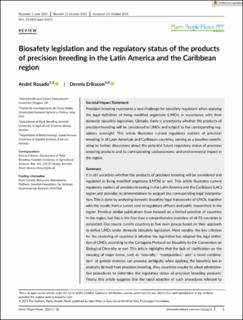| dc.contributor.author | Rosado, André | |
| dc.contributor.author | Eriksson, Dennis | |
| dc.date.accessioned | 2022-06-22T10:44:04Z | |
| dc.date.available | 2022-06-22T10:44:04Z | |
| dc.date.created | 2022-02-05T11:59:27Z | |
| dc.date.issued | 2021 | |
| dc.identifier.citation | Plants, People, Planet. 2021, . | en_US |
| dc.identifier.issn | 2572-2611 | |
| dc.identifier.uri | https://hdl.handle.net/11250/3000011 | |
| dc.description.abstract | Precision breeding represents a new challenge for biosafety regulators when applying the legal definition of living modified organisms (LMOs) in accordance with their domestic biosafety legislation. Globally, there is uncertainty whether the products of precision breeding will be considered as LMOs and subject to the corresponding regulatory oversight. This article illustrates current regulatory matters of precision breeding in all Latin American and Caribbean countries, serving as a baseline contributing to further discussions about the potential future regulatory status of precision breeding products and its corresponding socioeconomic and environmental impact in the region. It is still uncertain whether the products of precision breeding will be considered and regulated as living modified organisms (LMOs) or not. This article illustrates current regulatory matters of precision breeding in the Latin America and the Caribbean (LAC)region and provides recommendations to support the corresponding legal interpretation. This is done by analyzing domestic biosafety legal frameworks of LMOs, together with the results from a survey sent to regulatory officers and public researchers in the region. Previous similar publications have focused on a limited selection of countries in the region, but this is the first time a comprehensive overview of all 33 countries is presented. Our results classify countries in five main groups based on their approach to define LMOs under domestic biosafety legislation. Most notably, the key criterion for the clustering of countries is whether the legislation has adopted the legal definition of LMOs according to the Cartagena Protocol on Biosafety to the Convention on Biological Diversity or not. This article highlights that the lack of clarification on the meaning of major terms, such as “naturally”, “manipulation”, and “a novel combination” of genetic material, can provoke ambiguity when applying the biosafety law in products derived from precision breeding. Also, countries require to adopt administrative procedures to determine the regulatory status of precision breeding products. Finally, this article suggests that the rapid adoption of such procedures relevant to precision breeding is strongly connected to the role of agriculture and biotechnology in the countries and with national economic and political perspectives. | en_US |
| dc.language.iso | eng | en_US |
| dc.rights | Navngivelse 4.0 Internasjonal | * |
| dc.rights.uri | http://creativecommons.org/licenses/by/4.0/deed.no | * |
| dc.subject | biosafety law | en_US |
| dc.subject | biotechnology | en_US |
| dc.subject | Cartagena Protocol on Biosafety | en_US |
| dc.subject | Latin America and the Caribbean | en_US |
| dc.subject | living modified organism | en_US |
| dc.subject | precision breeding | en_US |
| dc.title | Biosafety legislation and the regulatory status of the products of precision breeding in the Latin America and the Caribbean region | en_US |
| dc.type | Peer reviewed | en_US |
| dc.type | Journal article | en_US |
| dc.description.version | publishedVersion | en_US |
| dc.subject.nsi | VDP::Matematikk og Naturvitenskap: 400 | en_US |
| dc.source.pagenumber | 214-231 | en_US |
| dc.source.journal | Plants, People, Planet | en_US |
| dc.source.issue | 4 | en_US |
| dc.identifier.doi | 10.1002/ppp3.10243 | |
| dc.identifier.cristin | 1998063 | |
| cristin.ispublished | true | |
| cristin.fulltext | original | |
| cristin.qualitycode | 1 | |

